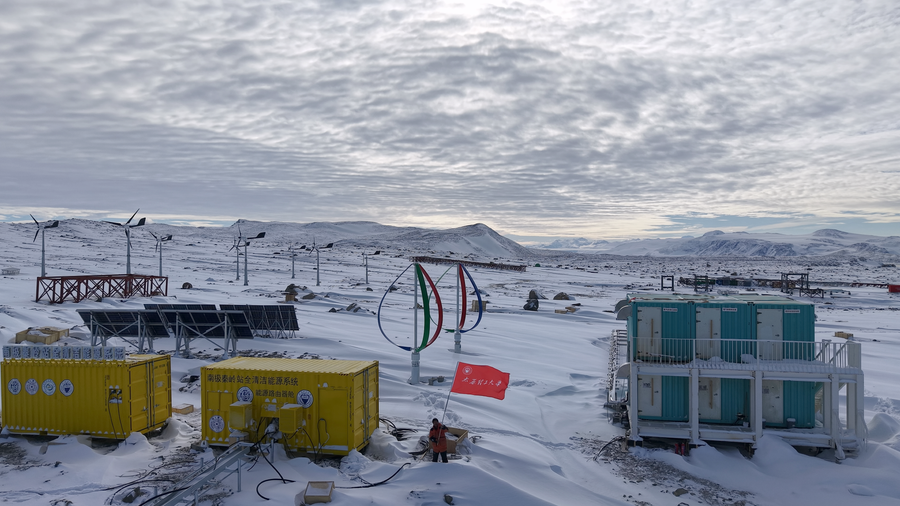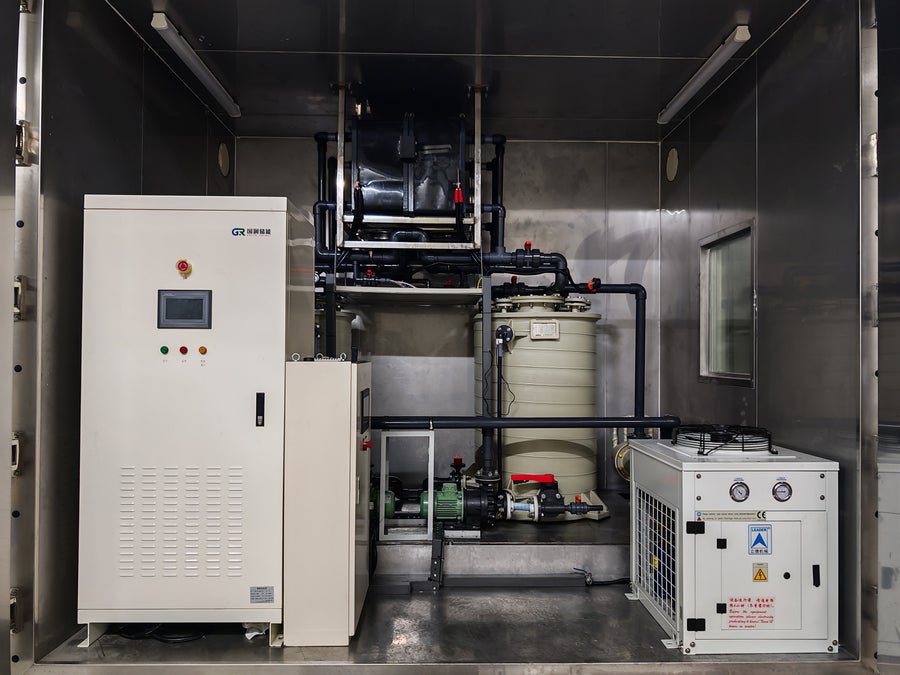Five years ago electrical engineer Sun Hongbin was given what many would consider an impossible task: build a full-fledged clean-energy system amid some of the coldest temperatures on Earth, screaming winds and half-year darkness.
China was then building its fifth Antarctic research station, called Qinling, on Inexpressible Island in Terra Nova Bay. And the nation’s government was pushing the concept of “green expeditions” to protect Antarctica’s uniquely fragile environment while studying and surveying the continent. “So having a system that would provide the bulk of Qinling’s energy with renewable power fit that goal,” Sun says.
But conventional solar and wind installations are no match for temperatures that plummet below –40 degrees Celsius, winds of up to 300 kilometers per hour (kmh) and ferocious blizzards. Such conditions can snap wind turbine blades, sharply reduce the performance of solar panels, and prevent batteries from charging and discharging properly. And of course, there are the six months of polar night, when the sun never rises above the horizon.
On supporting science journalism
If you’re enjoying this article, consider supporting our award-winning journalism by subscribing. By purchasing a subscription you are helping to ensure the future of impactful stories about the discoveries and ideas shaping our world today.

The clean-energy system at China’s Qinling research station in Antarctica comprises solar panels, wind turbines, a hydrogen energy system and batteries.
Members of China’s 41st Antarctic expedition team
“It was a huge challenge” to build a system for the Earth’s coldest, darkest and most remote continent, says Sun, now president of Taiyuan University of Technology in China and chief scientist for polar clean energy at the Polar Research Institute of China.
But in late 2024 his team traveled to the station to install a system that took $14 million to develop. It consists of 10 wind turbines, 26 solar modules, a hydrogen energy system, a container full of frost-resistant lithium-ion batteries and a smart grid that can predict and balance supply and demand. The entire renewable system is now running and, according to Sun, should provide half of the base’s average annual energy needs.
“The use of clean energy is a huge advancement to keep the continent clean,” says Kim Yeadong, chair of the Korean National Committee on Polar Research in South Korea, who was not involved with the project. “Other stations will probably have to learn how they achieve that much clean energy. I think it’s remarkable.”
Where Diesel Power Is King
A 2024 preprint analysis of 81 Antarctic research bases found that 37 had installed renewable-energy sources such as solar panels and wind turbines. But the proportion of renewable energy these bases used was “often low,” the researchers wrote. An exception so far has been Belgium’s Princess Elisabeth Station, which is only staffed during the Antarctic summer. It runs completely on wind and solar power, taking advantage of the almost 24-hour daylight. Even so, the vast majority of stations still depend on diesel-powered generators to keep their crews warm, fed and safe. The main reason this is the case is simply that “they are used to using diesel,” says Daniel Kammen, a professor of energy at the University of California, Berkeley.
But relying on diesel fuel has downsides: it is logistically difficult and expensive to transport bulky, liquid fossil fuels to such a remote location, often surrounded by sea ice. Highly specialized resources—typically including icebreakers and military personnel—are required to make the difficult refueling voyage, which usually takes place just once a year, under careful planning.

The area along the Ross Sea is known for its strong wind.
And the stakes are high for Antarctica’s relatively pristine and easily disrupted ecosystem. “Every station that has oil or other fuels has had spills,” Kammen says. Although major oil spills have been rare, any contamination can have severe consequences on Antarctic soil and water because it takes a long time for oil to break down in subzero temperatures. That is not to mention the toll that burning fossil fuels is taking on the Antarctic ecosystem through climate change.
So there is significant incentive to move away from diesel. Yet “conventional wind turbines, solar panels, battery storage and hydrogen energy systems are designed to work above –30 degrees [C], but the conditions of Antarctic stations are often much worse,” Sun notes. “In Qinling, for example, gales blow at 73 kmh or faster for more than 100 days every year. When this happens in cold temperatures, wind turbines become brittle and break easily.”
Plus, battery and hydrogen technologies—which are used to store wind and solar power for later use—were “not good enough” in the past to ensure that energy supplies for bases would be reliable around the clock and throughout the year, Kammen says.
Come Clean
To overcome those hurdles, Sun and his team built a 2,000-square-meter lab at Taiyuan University to simulate Antarctica’s extreme weather conditions. It features controls that can drop the indoor temperature to –50 degrees C, a wind machine that can blast out gusts of up to 216 kmh and snow generators that can whip up instant blizzards.
Over four years of testing, the team developed a number of Antarctic-ready renewable energy systems. One design is a turbine that eschews the pinwheel-like blades of a traditional windmill; instead it is shaped like an upended eggbeater, with both ends of each curved blade attached to a central pole. This design reduces the surface area of the blade being pushed on by the wind, minimizing stress on the structure while still capturing enough force to generate electricity. And it lowers the turbine’s center of gravity to help prevent it from toppling in the wind, Sun says.

A set of batteries being tested at a lab in Taiyuan University of Technology in China to see whether they can function in Antarctica.
His team also installed turbines that are conventionally shaped but use blades made with carbon fiber—a strong and lightweight material that can withstand temperatures as low as –50 degrees C, according to Wang Bin, one of the engineers who went to Antarctica to build the system. These blades are also shorter than standard ones so as to reduce contact with the winds and increase structural resilience, Wang says.
For the solar power system, a special supporting frame was built to secure the panels to the ground so that they can better weather gales and heavy snow. And instead of the usual aluminum alloy, the frame is made of fiber-reinforced plastic. The latter has lower thermal conductivity, Sun’s team explains, meaning the frame’s temperature changes much more slowly when cold sets in and thus doesn’t deform as easily.
Instead of storing power in the most commonly employed types of lithium-ion batteries, which function poorly in subzero temperatures, the team used lithium-titanate batteries. Their chemistry makes it easier for lithium ions to move around inside the battery during the charging and discharging processes in extremely low temperatures. The scientists also built a thermal case around the batteries to keep them warm and designed a system to collect and store their waste heat—which can be directed back into the case when its internal temperature becomes too low, Wang adds.

China’s Qinling station is expected to have more than half its energy coming from the renewable system.
Members of China’s 41st Antarctic expedition team
But perhaps the most significant step the team took was bringing hydrogen energy to Qinling to help power the station through the long and dark winter.
To produce renewable hydrogen, an apparatus called an electrolyzer is powered by wind and solar energy to split water molecules into oxygen and hydrogen. The latter goes into high-pressure tanks that can store it for more than a year; when full, the tanks alone can keep the entire base running for around 48 hours, according to Sun’s team. To do so, the hydrogen is directed into an electrochemical device called a fuel cell, where it reacts with oxygen from the air to produce electricity, with only water and heat as by-products. The former is recycled to use in further electrolysis, and the latter is stored to warm up the electrolyzer when it becomes too cold to run.
The renewable system can currently produce 60 percent of the overall output of Qinling’s energy system when it’s running at full blast, with the remaining 40 percent coming from diesel. But Sun and his team are determined to raise that percentage—and to bring clean-energy systems to other Chinese polar bases as well. “Sixty percent is a great start, but one needs to ramp up,” Kammen says. “The goal really needs to be 100 percent renewable energy all year-round.”




